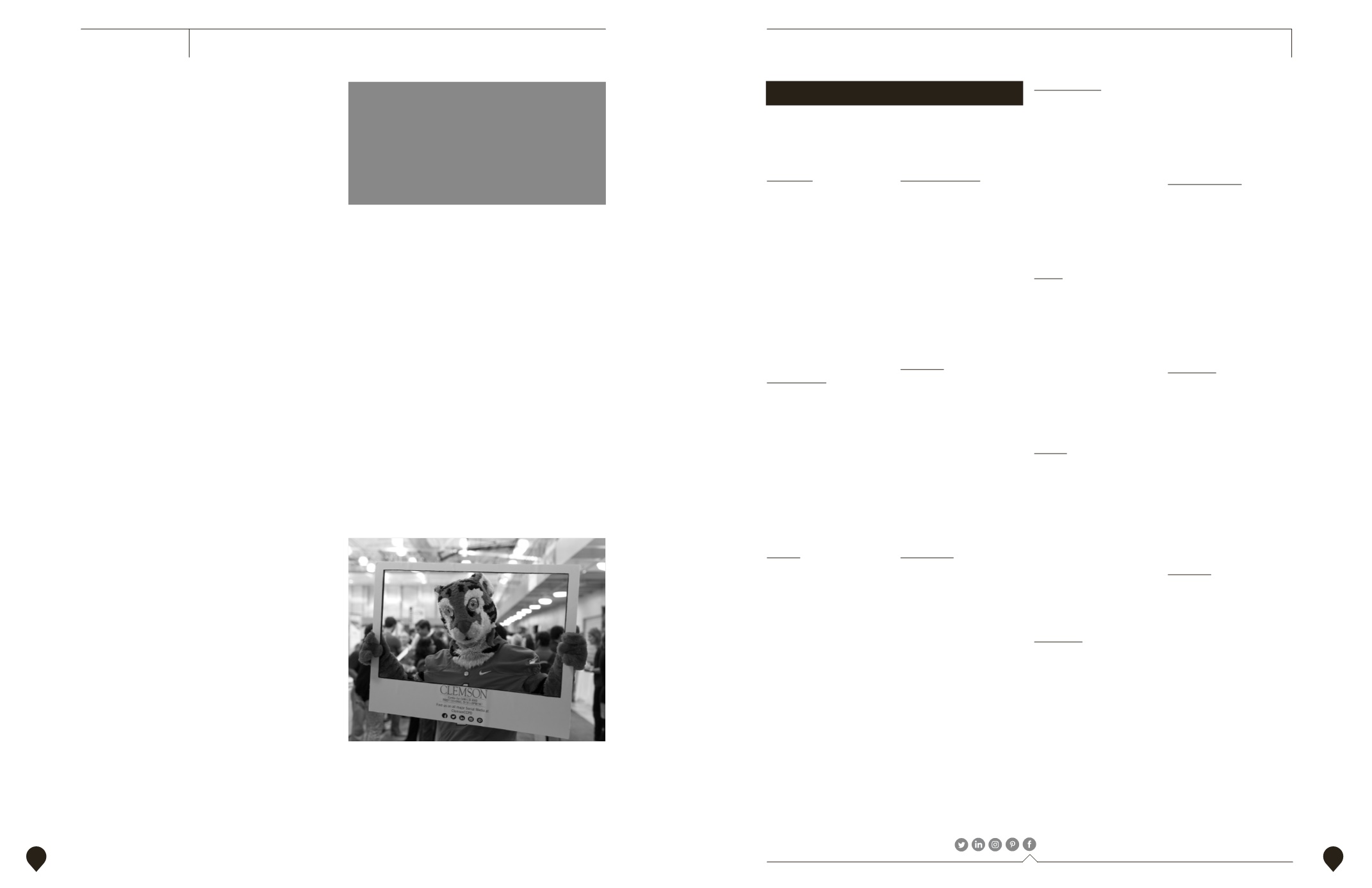

CAREER GUIDE 2017–2018
CLEMSON UNIVERSITY
clemson.edu/careerCENTER FOR CAREER AND PROFESSIONAL DEVELOPMENT
/ClemsonCCPD
39
38
EXPERIENCE – DEVELOPING CONTENT
Now that you know what kinds of experience to list in a résumé,
you need to know how each experience should be described.
Again, the employer’s point of view is your guide. Most employers
look for common strengths in their candidates. Therefore, the
descriptions of any jobs or activities should reflect both the
results you have achieved and your potential.
Where possible, quantify the work you have done. For example:
How much money did you raise? How many books did you
sell? Did you lead a 10-member or 100-member tour? Did you
graduate number five in a class of 10 or in a class of 100? Put
some objective scope on your work that can be judged positively
by potential employers.
Keep in mind that you must always be truthful. You are trying to
create a document that sells your virtues, but do not get carried
away. If you worked on just part of a project, do not take full
credit. If you waited tables, do not say you were the maitre d’.
Truth in advertising is a must.
Résumés should be tailored to each position to which you apply.
You need to show the employer that you are the best fit for the
position based on your previous experience and knowledge.
Print the position description and read it carefully for keywords
and responsibilities. Highlight terms that are repeated and/or
emphasized. Consider including these keywords on your resume
and include specific examples of your experience related to those
keywords and responsibilities. On average, employers spend
less than 10 seconds reviewing a résumé so make sure your
experience aligns with the position description.
It goes without saying that your résumé should be proofread
meticulously. Although one spelling error or typo rarely eliminates
you from consideration for a position, keep in mind that along
with your cover letter, your résumé is one of your writing samples.
It is a clear indicator of how well you communicate. If you miss
a typo, the employer will think, “Maybe this person will miss
important details while on the job, too.” Therefore, in addition to
reviewing the résumé yourself, ask a friend, professor or career
counselor to read your résumé. A new eye often picks up the
obvious typo that you have not seen for weeks.
WHAT ABOUT REFERENCES?
It is not necessary to include the phrase “References Available
upon Request” on your résumé. It is always a good idea, however,
to have a list of your references with their names, addresses,
email addresses and phone numbers on a separate sheet to hand
to the interviewer. Remember to always obtain permission from
your references before using them.
An example of a reference:
Mr. Harry Winston
Chief Financial Officer
Wachovia Bank
Charlotte, NC 26751
704-555-1212
winston
@
wachovia.org
SOME FINAL THOUGHTS…
In addition to perfecting the content of your résumé, you will
want to take a critical look at the format. Your résumé should be
appealing to the eye and utilize consistent formatting. Stay away
from résumé templates; those programs seem easy at first but
result in a résumé that will look too similar to other applicants.
Typically, your résumé should be printed on quality bond paper
produced by a high-quality photocopier, laser printer or offset
printing service. These processes ensure a consistent quality
from résumé to résumé.
Be conservative when it comes to the color of your résumé.
Acceptable colors include white, beige and gray. You take a
chance by using other colors. Also avoid using grainy textured
papers. Keep the size of the paper to the standard 8½ x 11 page.
A legal size résumé may stick out in a pile and does not fit into
standard filing systems. Use a font size between 10 and 12 point
in a professional font style, such as Arial or Times New Roman.
In order to encourage potential employers to learn about your
qualifications, the résumé format must be attractive and easy
to read.
Accounting
Record
Assess
Audit
Prepare
Maintain
Forecast
Calculate
Estimate
Figure
Appraise
Examine
Measure
Verify
Administration
Monitor
Track
Assess
Coordinate
Organize
Requisition
Access
Receive
Process
Serve
Furnish
Analysis
Assess
Observe
Review
Dissect
Interpret
Discern
Conceptualize
Discover
Infer
Illuminate
Clarify
Quantify
Qualify
Conclude
VERBS TO USE IN RESUME WRITING
The following words are those that best describe the duties
and functions executed in summer, part-time and full-time
jobs, internships, co-ops and while involved in co-curricular
activities.
Counseling/Healing
Listen
Sense
Intuit
Assess
Analyze
Assist
Align
Coordinate
Understand
Inform
Facilitate
Help
Consulting
Troubleshoot
Problem solve
Assess
Assist
Arrange
Guide
Counsel
Survey
Serve
Contribute
Motivate
Train
Craft/Artisan
Design
Create
Build
Entertain
Perform
Draw
Render
Illustrate
Compose
Construct
Conceive
Choreograph
Design/Organize
Explore
Formulate
Sketch
Draw
Draft
Layout
Create
Plan
Style
Pattern
Build
Display
Editing
Review
Analyze
Compare
Comment
Correct
Revise
Amend
Improve
Initiate
Investigate
Advise
Finance
Analyze
Invest
Budget
Inventory
Evaluate
Appraise
Construct
Develop
Acquire
Deploy
Manage
Project
Fundraising
Research
Analyze
Strategize
Program
Develop
Contact
Inquire
Inform
Motivate
Direct
Persuade
Monitor
Coordinate
Human Resources
Assess
Analyze
Recruit
Survey
Screen
Interview
Select
Train
Mediate
Appraise
Coordinate
Align
Information
Appraise
Analyze
Inventory
Structure
Design
Categorize
Document
Process
Manage
Program
Link
Coordinate
Organize
Innovating
Create
Modify
Change
Upgrade
Improve
Design
Activate
Restructure
Establish
Stimulate
Implement
Transform
















